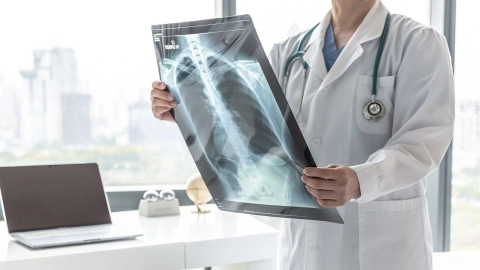ICD-Code C34.8: Malignant neoplasm: Overlapping lesion of bronchus and lung
You have lung cancer.
The tissue in the body is made up of cells. With cancer, the cells multiply uncontrollably, which leads to a malignant neoplasm (abnormal growth of tissue) developing. The cancer cells can destroy the healthy tissue and spread throughout the body.
The lungs are on the left and right side of the ribcage. They are also connected to the nose and mouth via the bronchial tubes and windpipe (trachea). The air is breathed in through the mouth or nose. From there the air goes into the trachea via the larynx. At the end of the windpipe are two bronchial tubes (or bronchi) branching away from it. The bronchial tubes run into the lungs. What is more, the bronchial tubes divide into even smaller branches. The larynx, the trachea, the bronchia and the lungs are part of the lower airways.
The lungs are divided into 3 different parts – an upper, a middle and a lower lobe. Your lung cancer is in several parts of the lung or in the large bronchi.
Please note: This ICD code may also derive from the ICD-O system. If this is the case, there are usually additional letters and numbers in addition to the code. It starts with the letter M, followed by 4 digits and then a slash. There is another digit after the slash.
If it is an ICD-O code, then this does not describe a malignant cancer in all cases. The last digit after the slash gives you more detailed information about this:
- /0 – The tumor is benign. Cells in a tissue multiply uncontrollably. However, they are not destroying the surrounding tissue and are also not spreading throughout the body.
- /1 – It is not known for sure whether the tumor is benign or malignant.
- /2 – It is an early form of cancer, a precancerous stage where the cells are altered and multiply uncontrollably. However, they are not yet spreading beyond a certain margin and cannot spread to other organs either.
- /3 – It is a malignant cancer. The cells in the affected tissue are altered and multiply uncontrollably. They can destroy the surrounding tissue and spread throughout the body.
- /6 – It is a metastasis. Cancer cells have spread from the originally affected site to a different site in the body and have further multiplied there.
- /9 – It is either a malignant cancer or a metastasis. The cells in the affected tissue are altered and multiply uncontrollably. However, it is impossible to say whether these cells derive originally from the affected site or have spread there from a different site in the body.
Additional indicator
On medical documents, the ICD code is often appended by letters that indicate the diagnostic certainty or the affected side of the body.
- G: Confirmed diagnosis
- V: Tentative diagnosis
- Z: Condition after
- A: Excluded diagnosis
- L: Left
- R: Right
- B: Both sides
Further information
Source
Provided by the non-profit organization “Was hab’ ich?” gemeinnützige GmbH on behalf of the Federal Ministry of Health (BMG).

